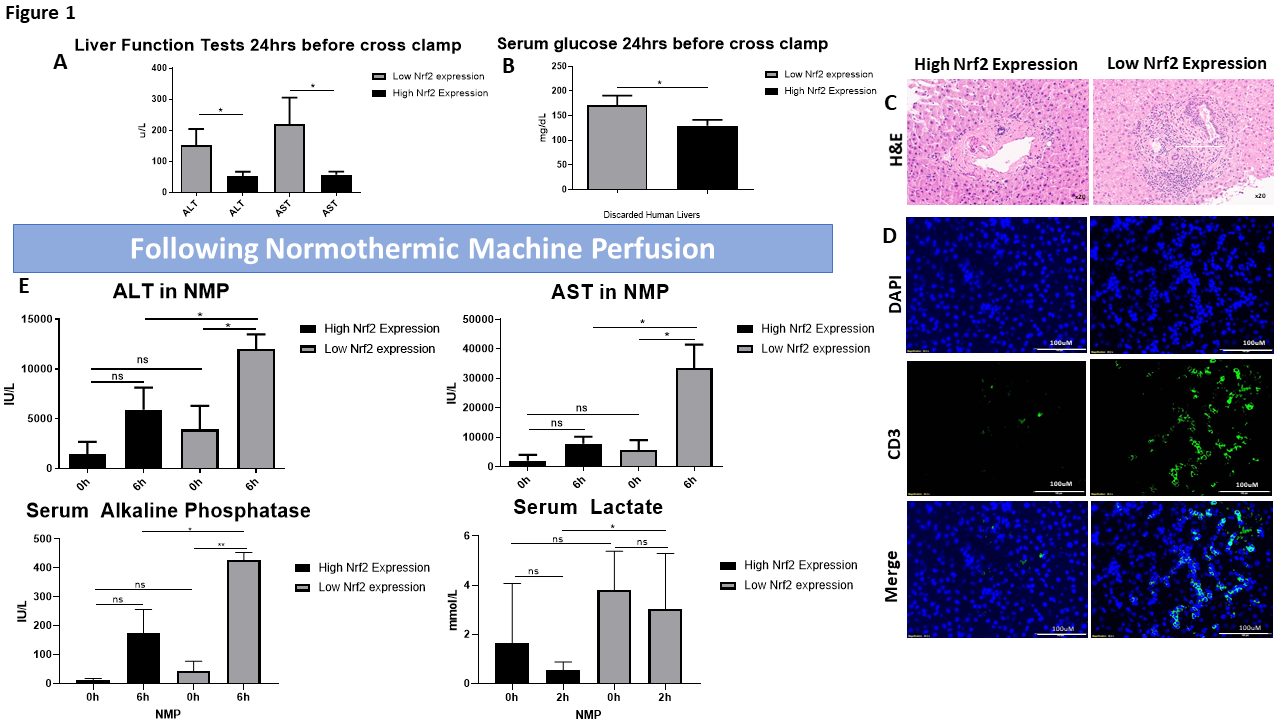Nrf2 Assessment in Discarded Liver Allografts: A Role in Allograft Function and Salvage
Surgery, Washington University School of Medicine, Saint Louis, MO
Meeting: 2021 American Transplant Congress
Abstract number: 625
Keywords: Donors, marginal, Graft function, Liver transplantation, Machine preservation
Topic: Clinical Science » Biomarkers, Immune Assessment and Clinical Outcomes
Session Information
Session Name: Biomarkers, Immune Assessment and Clinical Outcomes
Session Type: Poster Abstract
Session Date & Time: None. Available on demand.
Location: Virtual
*Purpose: With mounting pressures to optimize organ availability for transplantation, there is a focus on reducing organ discard and attempting to resuscitate declined grafts for later use. The nuclear factor erythroid 2-related factor-2 (Nrf2) axis may be an important mediator in allograft function. This study aimed to determine the functional expression and clinical relevance of Nrf2 in discarded human livers.
*Methods: Biopsies from 40 discarded liver allografts were studied. Nrf2 expression was quantified by immunoblotting and patients were stratified into a high Nrf2 and low Nrf2 group. Relevant donor clinical and biochemical data were compiled. The modified Suzuki scoring system and Banff criteria were used for histological grading of hepatic injury. Inflammatory infiltration was quantified by immunofluorescence for CD3-positive cells. Allografts (n = 8) were exposed to 6 hours of normothermic machine perfusion (NMP). Liver function (LFT) and lactate clearance were recorded pre- and post NMP to determine viability. Advanced CellSens and GraphPad software were used for biostatistical analysis.
*Results: Livers with greater Nrf2 levels demonstrated lower ALT (mean 53 IU/L vs 152 IU/L, p = 0.049) and AST (58 IU/L vs 220 IU/L, p =0.045) prior to organ procurement (Figure 1A). Serum glucose (mean 171 mg/dL vs 126 mg/dL, p = 0.046) (Figure 1B) and hepatic glycogen content were both higher in the low Nrf2 group. Greater vascular endothelial inflammation (Figure 1C) around the hepatic artery (p = 0.01) and portal vein (p = 0.003) was observed in livers with lower Nrf2 expression and these organs also demonstrated increased periportal CD3 infiltration (p < 0.01) (Figure 1D). Following 6 hours of NMP, livers with higher Nrf2 expression demonstrated lower LFT derangements (ALT 5919 IU/L vs 12000 IU/L; AST 7817 vs 33405 IU/L) and healthier lactate clearance (0.5 mmol/L vs 2.98mmol/L) compared to allografts with lower Nrf2 expression (p < 0.05) (Figure 1E).
*Conclusions: This study highlighted the association of a rich Nrf2 environment with more favourable clinical parameters and its potential impact on the functionality of discarded liver allografts. Nrf2 expression may act as a useful marker to differentiate between salvageable discarded allografts and targeting the Nrf2 axis could have a rationale in future studies.
To cite this abstract in AMA style:
Ahmed O, Xu M, Zhou F, Wein AN, Upadhya G, Lin Y, Chapman W. Nrf2 Assessment in Discarded Liver Allografts: A Role in Allograft Function and Salvage [abstract]. Am J Transplant. 2021; 21 (suppl 3). https://atcmeetingabstracts.com/abstract/nrf2-assessment-in-discarded-liver-allografts-a-role-in-allograft-function-and-salvage/. Accessed December 13, 2025.« Back to 2021 American Transplant Congress

